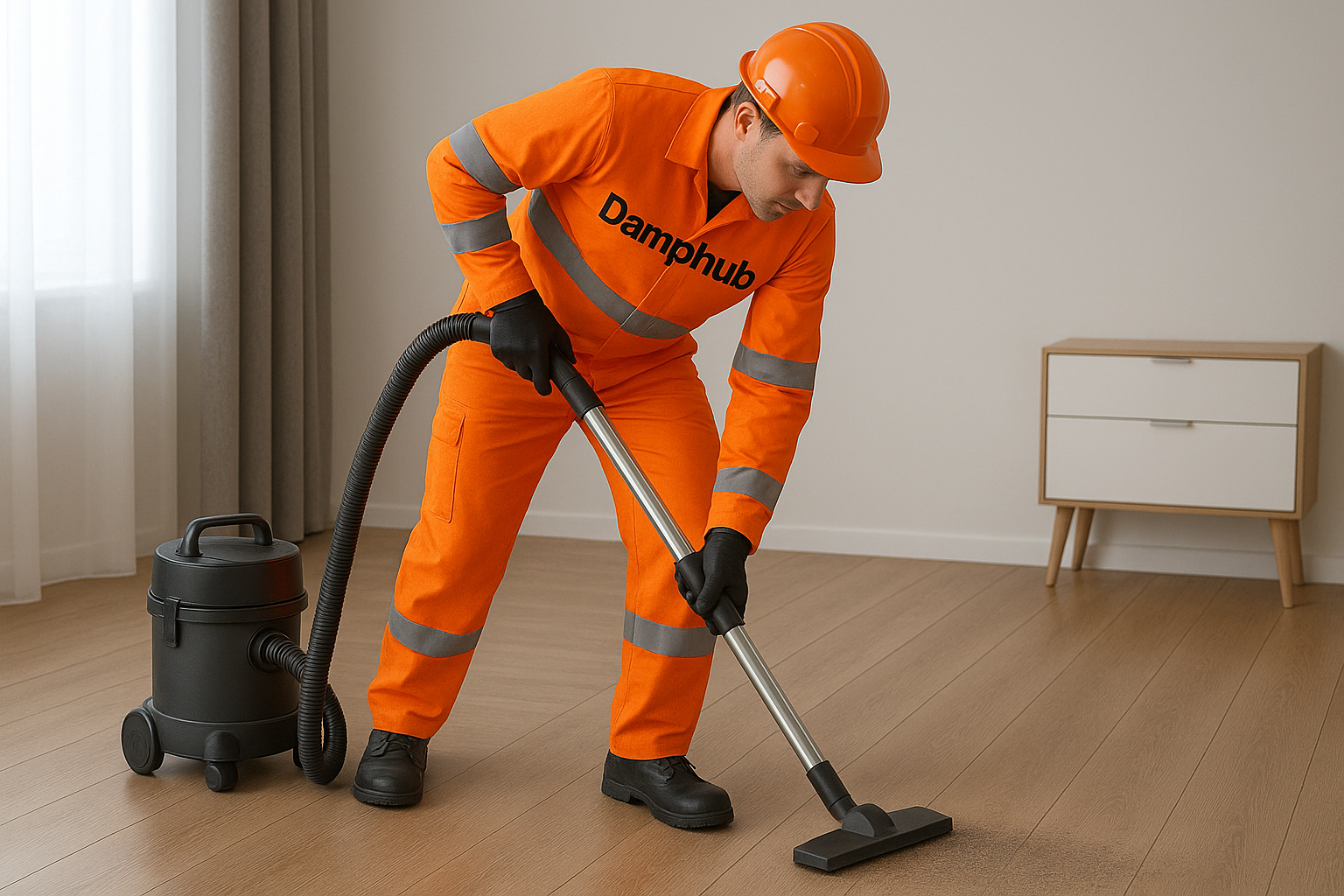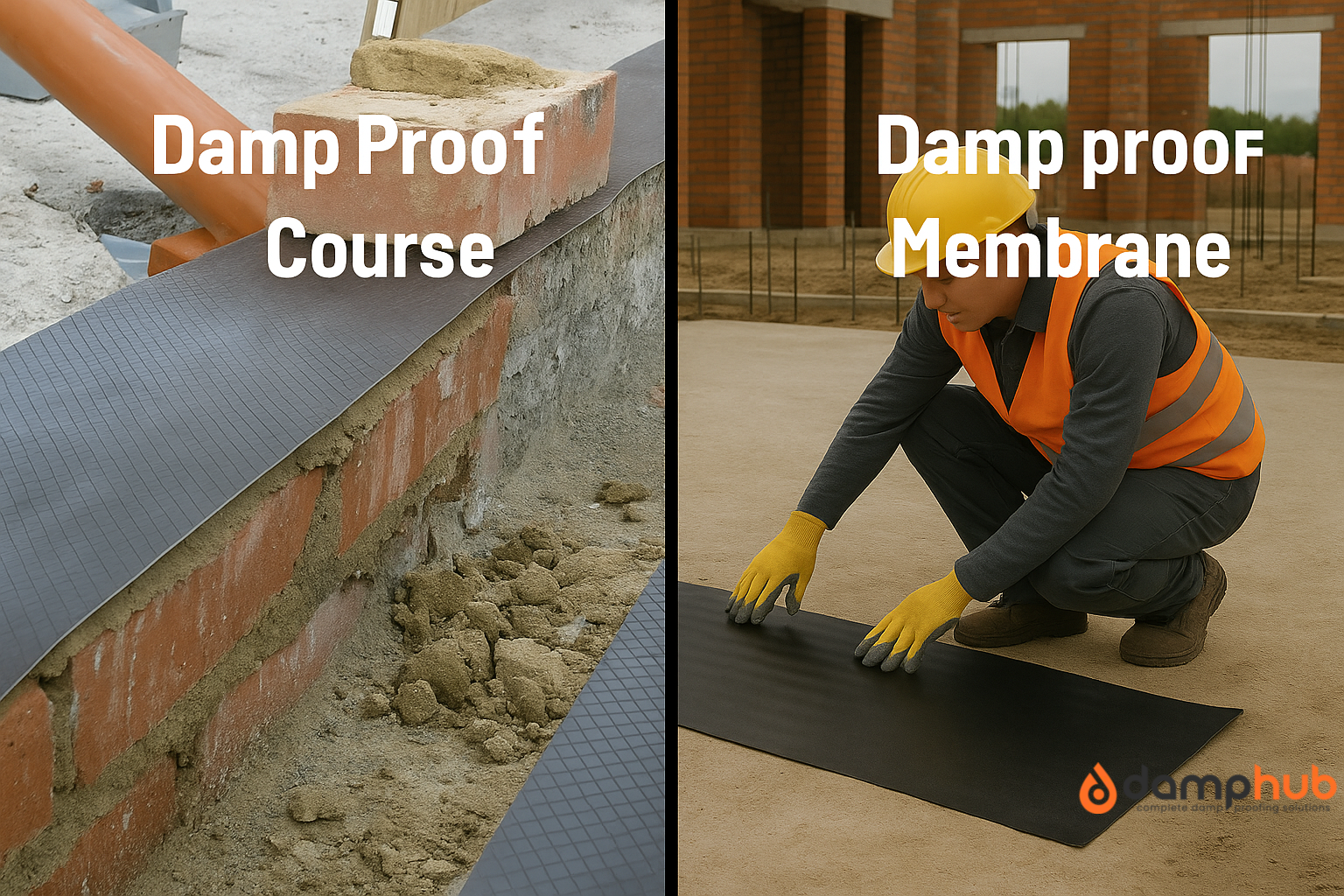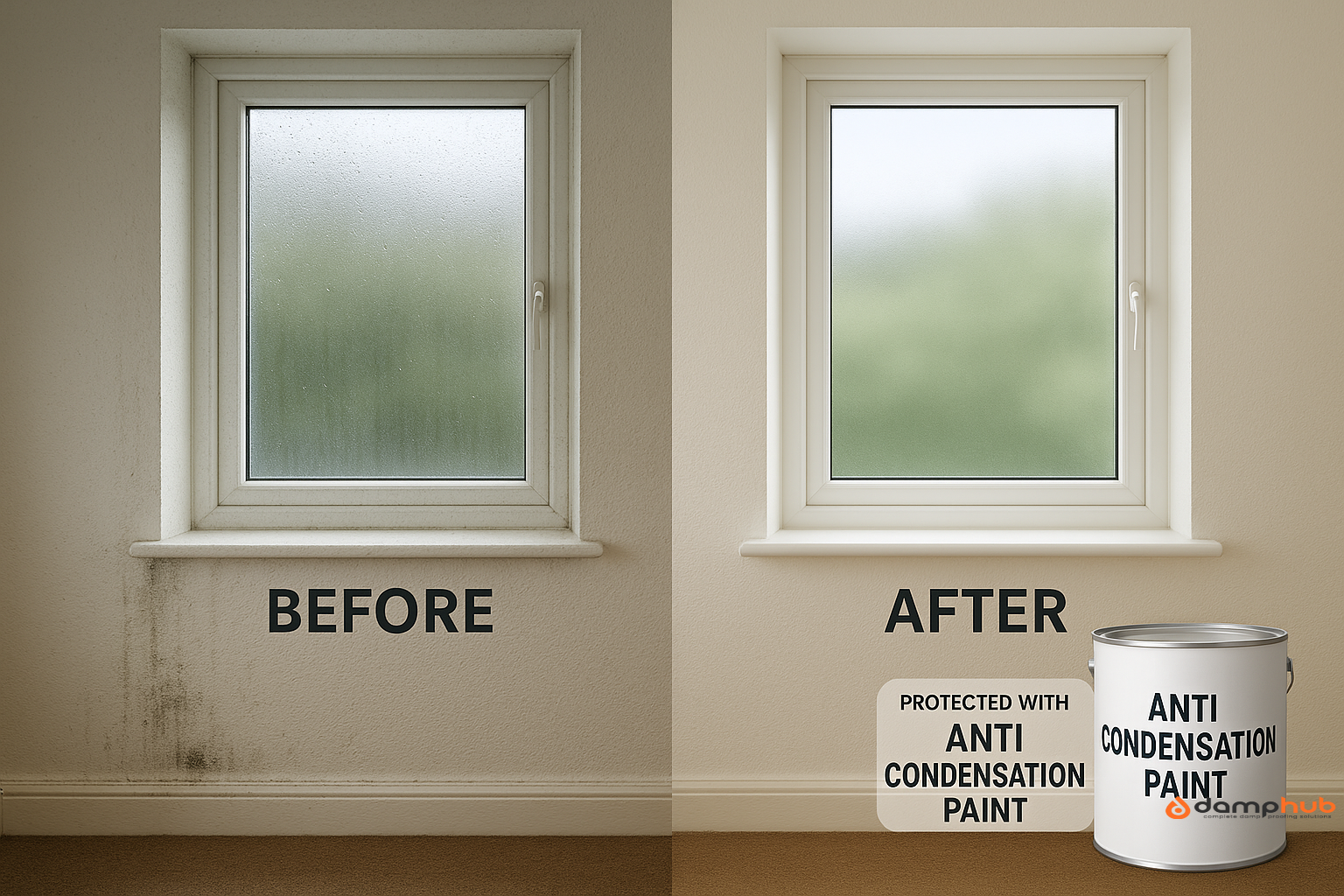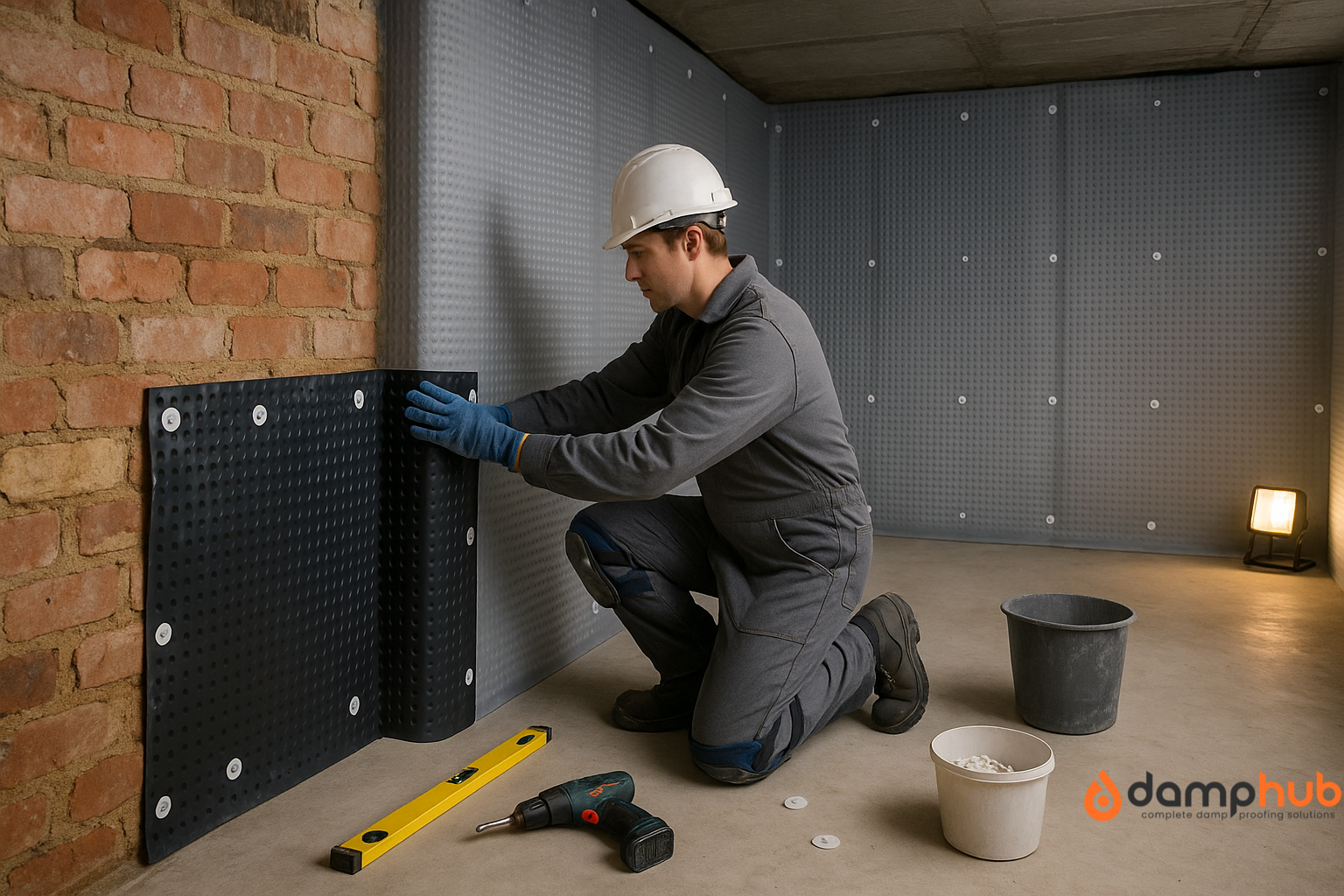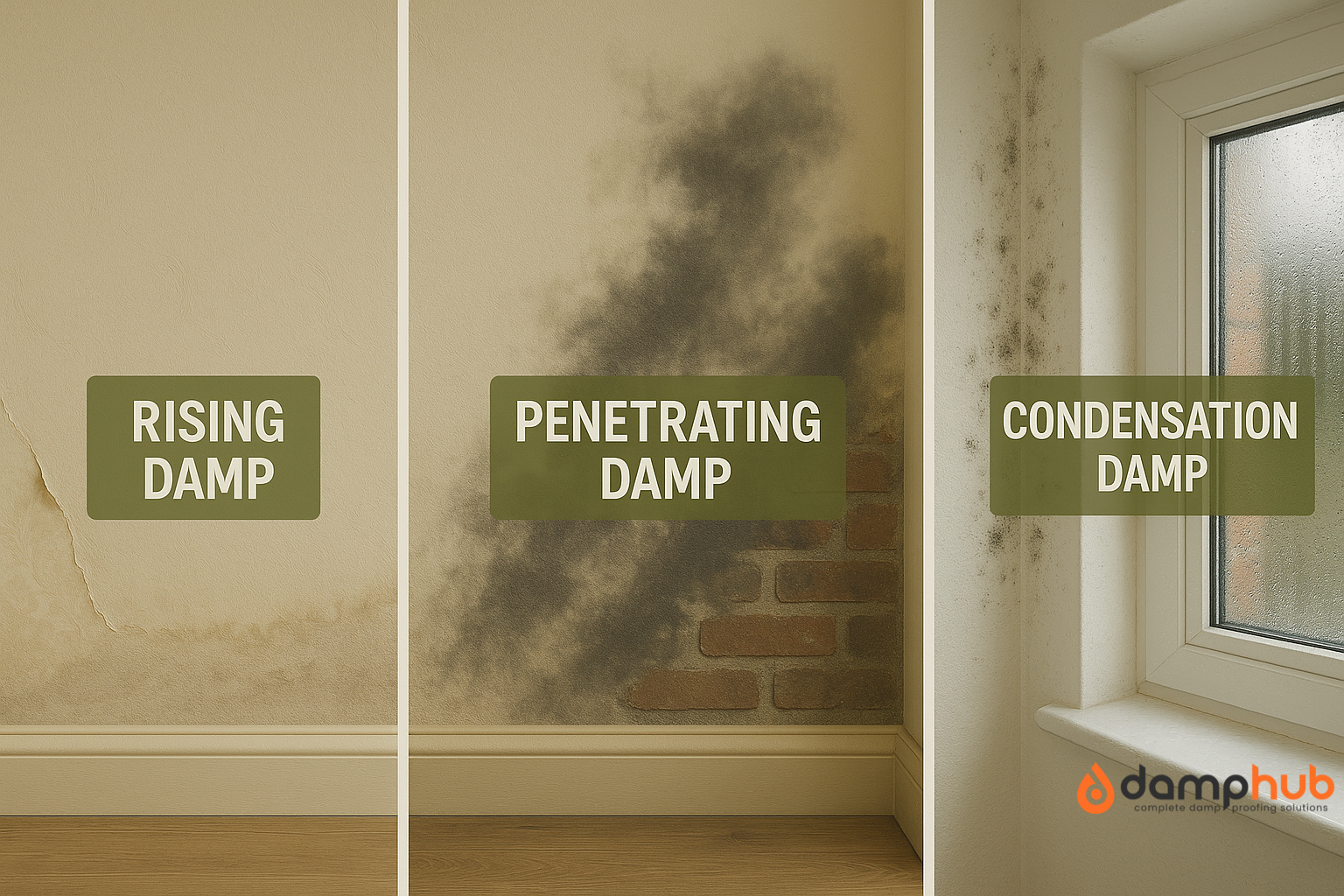
You don’t need to be knee-deep in water to have a damp problem. Sometimes it’s just a cold patch on the wall that never dries. Or a salty tide mark creeping up from the skirting. Every type of damp behaves differently — and the fix depends on getting the diagnosis right first.
This guide breaks down the main types of damp found in UK homes, what causes each one, and how you can tell them apart.
👉 Make sure to read: How to Get Rid of Damp: A Professional Guide
What are the different types of damp?
There are three main types of damp you’ll come across in UK homes. Each has a distinct pattern, location, and cause — but they often get mistaken for one another.
1. Rising Damp
Rising damp is moisture that travels up from the ground through the bricks and mortar. It’s usually found on ground-floor walls and often leaves a visible tide mark about a metre high. Skirting boards can start rotting, plaster crumbles, and wallpaper bubbles at the base.
It’s slow-moving and not always obvious at first — but left alone, it can eat into structural materials.
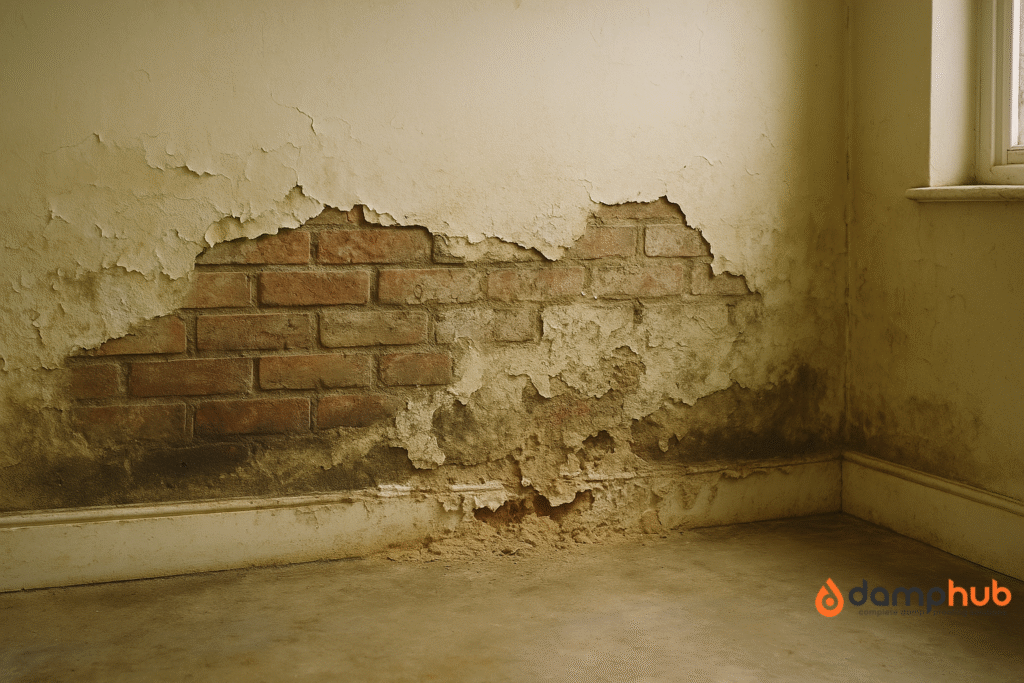
2. Penetrating Damp
Penetrating damp comes sideways — not up. It’s caused by rainwater or leaks getting through walls, roofs, or windows. Look for damp patches that grow after heavy rain, especially around chimneys, corners, or ceilings.
Unlike rising damp, it doesn’t stop at ground level. It can appear anywhere, depending on where the water is getting in.

3. Condensation
This is by far the most common and most misunderstood. Condensation is internal moisture — from cooking, breathing, showers — that hits cold surfaces and forms water droplets.
It often shows up as black mould in corners, around windows, or behind furniture where air doesn’t circulate well.
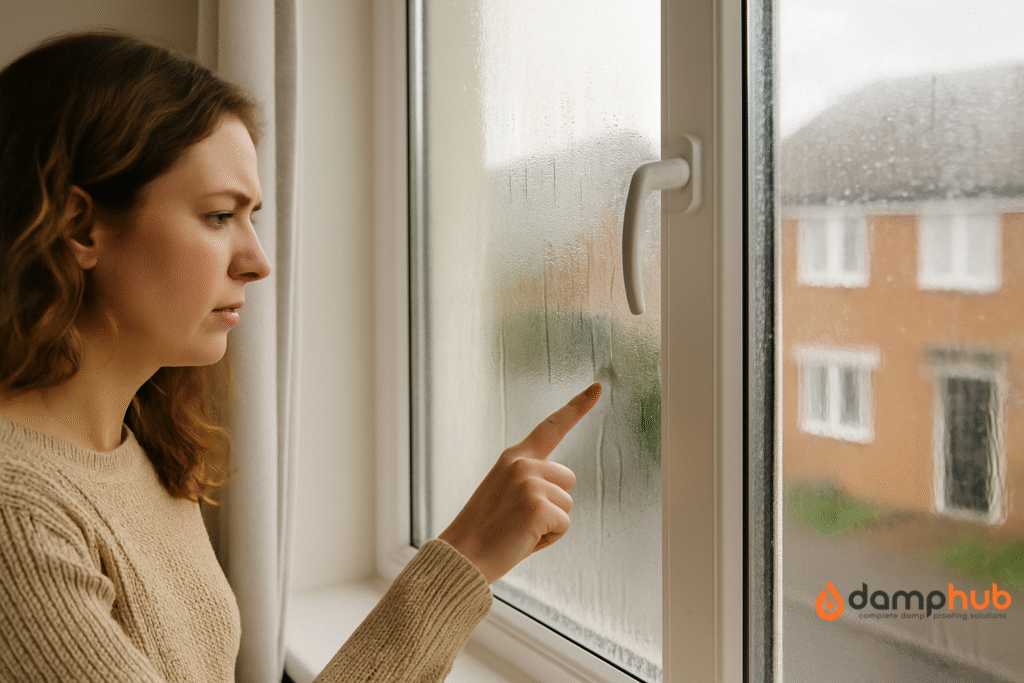
Less Common Types of Damp
- Lateral Damp: Seen in basements and cellars, where moisture seeps horizontally through underground walls.
- Splashback Damp: Happens when rain splashes up from hard surfaces (like patios) onto unprotected lower brickwork.
👉 Our other post: How to Damp Proof a House: 7 Practical Tips from Industry Experts
What Causes the Various Types of Damp?
Not all damp is the same — and neither are the reasons behind it. Rising damp creeps up from the ground, penetrating damp breaks in from outside, and condensation builds from everyday living.
Each has its own clues. Once you know what’s behind the stains or peeling paint, the fix becomes clearer.
Rising Damp
- Missing DPC: Some older properties were built before damp proof courses became standard. That means nothing is stopping groundwater from rising straight into your walls.
- Bridged DPC: If someone’s added a flower bed or patio that sits higher than your DPC line, you’ve now got a shortcut for damp to sneak in.
- Damaged DPC: Even solid barriers like slate or bitumen can crack or degrade over time, making them useless against rising moisture.
- No floor membrane: If there’s no plastic sheet under your concrete floor, moisture can rise from below and settle around the skirting or floor edges.
👉 Get more info: Is Rising Damp Dangerous?
Penetrating Damp
- Cracked render or bricks: Gaps in your wall’s outer skin let rainwater in — especially during wind-driven storms. Over time, those little cracks add up.
- Worn pointing: Missing or crumbling mortar between bricks acts like an open invitation for rainwater to soak through.
- Leaking gutters: If water’s constantly pouring down the side of your house, don’t be surprised when it starts seeping into the wall behind.
- Loose or missing tiles: Just one tile out of place can let water straight into your loft or down the internal wall.
- Dodgy window seals: If the sealant around your windows has cracked or shrunk, rain can seep in and leave damp patches around the frames.
- Hidden pipe leaks: Not all damp comes from outside — a slow leak inside a wall or under a floor can stay hidden for months, only showing up as discolouration or musty smells.
👉 Also from us: How to Treat Damp Walls Before Painting
Condensation
- Poor airflow: Kitchens and bathrooms pump out moisture daily. If there’s no fan, vent, or open window, it all settles inside.
- Cold surfaces: Uninsulated walls or single-glazed windows cool down fast, giving water vapour somewhere to cling to.
- Inconsistent heating: Turning the heat on and off too often makes temperature swings — and condensation loves a cold surface.
- Drying laundry indoors: One drying rack’s worth of clothes can release litres of moisture into your home. If it can’t escape, it settles.
- Sealed homes: Double glazing and modern insulation are great for warmth — but without a way for air to circulate, moisture gets trapped.
For more guide, you can also check: Fixing damp and condensation by Energy Saving Trust UK
How Can You Tell the Types of Damp You Have?
The clues are in the location, appearance, and how the damp behaves over time.
| Symptom | Likely Type |
|---|---|
| Damp above skirting, under 1m | Rising damp |
| A patch grows after rain | Penetrating damp |
| Black mould in corners | Condensation |
| Salt staining on the internal wall | Penetrating damp |
| Salt staining on internal wall | Rising damp or condensation |
| Damp behind the wardrobe or bed | Condensation |
Try This:
Tape a piece of foil over a damp patch for 24 hours. If moisture forms behind the foil, it’s coming from the wall (rising or penetrating damp). If it forms on the outside, it’s condensation.
How Do You Treat Each Type of Damp?
Damp doesn’t fix itself. And while the black spots or flaking paint might look the same, the solution depends entirely on the type of damp you’re dealing with.
Treat the symptoms without tackling the source, and it’ll be back before long — often worse. Below, we break down what actually works for each one.
Treating Rising Damp
- Inject a new DPC: Drill holes into the affected wall and inject a chemical damp proofing cream to create a fresh barrier against rising moisture.
- Install a damp proof membrane: In ground-floor areas or severe cases, lay a plastic sheet beneath the floor or behind plaster to physically block moisture.
- Hack off and replaster: Remove salt-contaminated plaster and replace it with breathable renovating plaster to prevent salts from drawing in damp again.
- Check for bridging: Make sure soil, render, or paths haven’t risen above the original DPC. Lowering the ground level can sometimes fix the issue without injection.
Read our full guide: How to Cure Rising Damp in an Old House
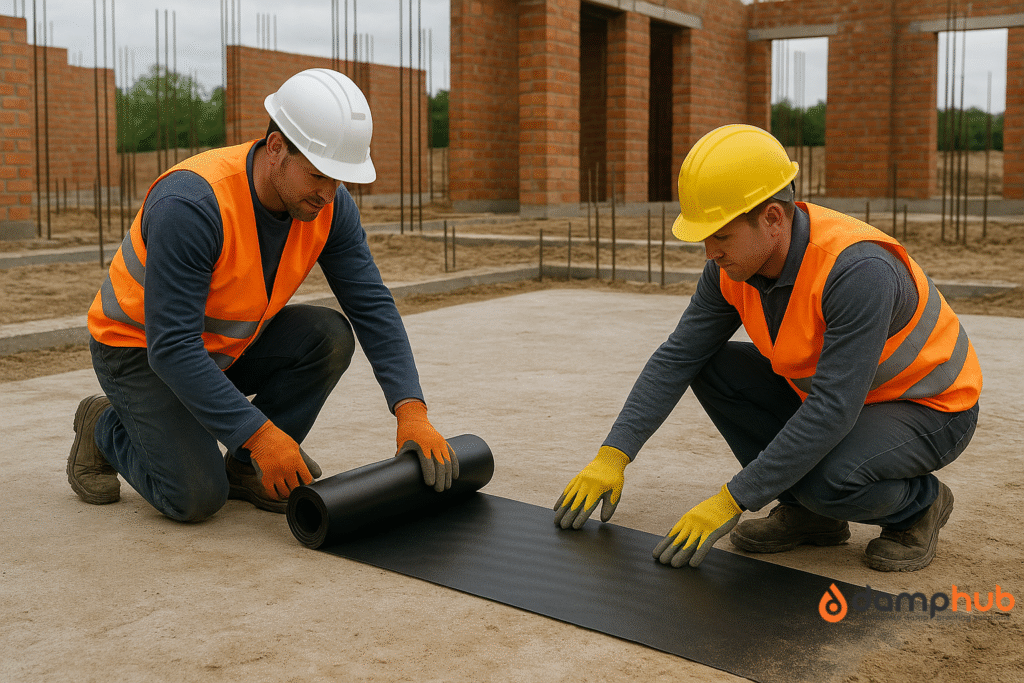
Pro Tip:
Never rely on damp-proof paint for rising damp — it only hides the issue, and pressure behind the paint can cause bubbling or peeling later.
Fixing Penetrating Damp
- Inspect the building envelope: Check external walls, pointing, window seals, and the roof for cracks or gaps. Repair or replace anything that’s letting in water.
- Fix broken gutters or downpipes: Overflowing or cracked rainwater goods can drench your walls — keep them clear and properly connected.
- Seal external cracks: Even tiny gaps can let rain in. Use breathable sealant or filler and consider a water-repellent treatment for solid walls.
- Address internal damage last: Only once the outside is sound should you strip back internal plaster and redecorate.
Try This:
On a dry day, gently hose sections of the wall from outside and check inside for signs of water — it’s a rough but revealing test.
Solving Condensation
- Increase ventilation: Open windows, use extractor fans, or install PIV systems to help damp air escape and reduce steam build-up.
- Use a dehumidifier: These pull moisture from the air and are handy in bedrooms or unventilated spaces. They’re quick but not a permanent fix.
- Improve insulation: Cold walls trigger condensation. Add insulation boards or double glazing to reduce temperature differences indoors.
- Control moisture sources: Avoid drying clothes indoors without ventilation, and keep lids on pans. Every bit of steam adds up in a sealed room.
- Treat mould directly: Once the area’s dry, clean mould with a specialist spray or white vinegar. Use anti-mould paint if the spot is prone to regrowth.
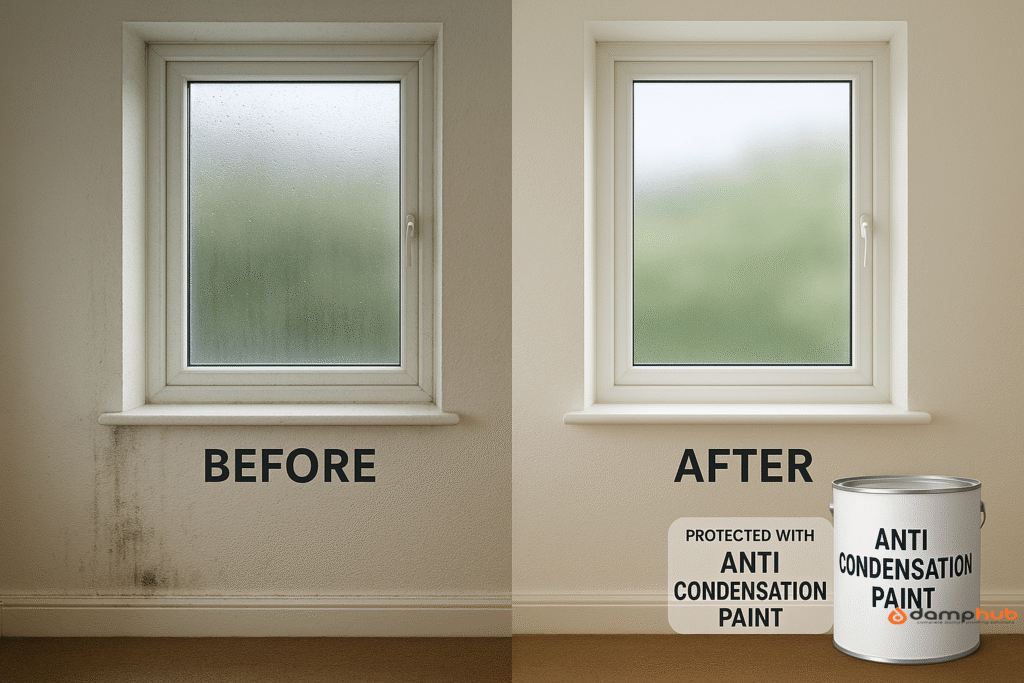
Good to Know:
One load of washing can release up to two litres of water into the room. If your windows drip overnight, your drying rack may be to blame.
👉 More from us: How to Treat Damp Walls Internally: A Step-by-Step Guide
Can Multiple Types of Damp Happen at Once?
Yes — and it’s more common than you’d think. A home might have condensation upstairs and penetrating damp on the gable wall. Or rising damp combined with poor ventilation.
The trick is not to treat one and ignore the other. If in doubt, call in someone who knows how to check for all three.
When to Get a Damp Specialist
If you’ve tried all the basics — like improving ventilation, sealing gaps, or repainting — and the problem keeps coming back, it’s time to speak to a professional.
Search for a damp specialist near me who can do a proper survey. They’ll check moisture levels inside the walls, spot any hidden leaks, and confirm whether it’s condensation or something deeper.
You might also ask how they recommend how to treat damp walls internally, especially if you’re dealing with repeated mould or flaking plaster.
Get help now: 10 Best Damp Survey Companies in London
Comparison Table for Different Types of Damp
| Type of Damp | Key Cause | Common Signs | Usual Location | Treatment Approach |
|---|---|---|---|---|
| Rising Damp | Moisture from the ground moving upward | Peeling paint, tide marks, salts on walls | Ground-level walls (especially older homes) | Damp-proof course (DPC), replastering |
| Penetrating Damp | Water entering through walls or roofs | Damp patches that worsen in rain, musty smell | Exterior walls, ceilings, around windows | Fix leaks, improve rendering, seal cracks |
| Condensation | Warm moist air condensing on cold surfaces | Streaming windows, black mould, mildew | Bathrooms, kitchens, corners of rooms | Improve ventilation, use dehumidifiers, insulation |
Final Thoughts
There’s no one-size-fits-all fix when it comes to damp. Every home is different — and every problem has a root cause. If you know how to spot the main types of damp, you’re already one step ahead.
Just don’t wait too long. Moisture rarely goes away on its own.
Answering Your Questions on Types of Damp
What is the difference between rising damp and penetrating damp?
Rising damp travels upward from the ground through walls due to capillary action. Penetrating damp enters sideways from external sources like rain or leaks.
How to identify where the damp is coming from?
Check patterns: low-level damp suggests rising damp, while patches higher up or near windows point to leaks or condensation. Use a moisture meter to confirm.
How do surveyors check for damp?
Surveyors use moisture meters, thermal imaging, and visual inspection to locate damp, assess severity, and identify whether it’s rising, penetrating, or condensation.
How do you test for damp in a house?
Use a handheld moisture meter on walls and skirting boards. Look for musty smells, flaking paint, or dark patches. DIY tests work, but a survey is more reliable.
How much damp is acceptable?
Internal walls should show less than 20% moisture content. Anything above that may indicate a damp issue and should be investigated further.
Read our full guide: What Percentage Damp Is Acceptable In Walls?
How much should damp proofing cost?
In the UK, damp proofing typically costs £60–£100 per metre. Full treatments may run from £1,000 to over £4,000, depending on the method and extent of the damage.
Read our related posts for more guides on cost: How Much Does Damp Proofing Cost? and How Much Can Damp Devalue Your Home?
How long does it take for walls to dry out after damp proofing?
Walls usually take 6–12 months to dry fully, depending on thickness and ventilation. Dehumidifiers can help speed it up.
How soon can you plaster after damp proofing?
Wait at least 4–6 weeks after damp proofing before plastering. For injected DPCs, follow the specialist’s guidance, as early plastering can trap moisture.

